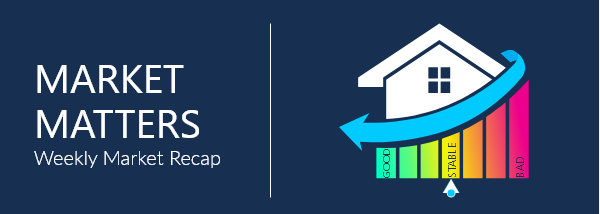Market Matters

The biggest event this week was the Fed’s Chairman Powell’s virtual Jackson Hole speech on Thursday morning where the Fed moved their policy of inflation targeting to an average inflation targeting. This will allow inflation to run over the 2% mandate target for some time when inflation has run below the 2% mandate. The market had a mixed reaction to Powell’s speech, as in theory this will allow the Fed to keep rates lower for longer, while it will also increase inflation expectations as well. The Republication National Convention was this week, which should start the campaign season and may have the markets paying closer attention to the upcoming elections in November.
 Initial Jobless Claims
Initial Jobless Claims
Initial Jobless Claims filed in the week August 22nd fell by -98k to 1.006mln vs. the prior week’s revised print of 1.104mln (orig. 1.106mln). The 4-week moving average fell to 1.068mln from 1.175mln in the previous week. Continuing claims, which lag by a week, fell -223k to 14.535mln from a revised 14.758mln (orig. 14.844mln). The 4-week average of continuing claims was 14.535mln, the lowest result since the week of April 18th at 13.298mln. It’s being estimated that it will be at least another 7-8 weeks until continuing claims fall under the 10mln mark.
 Pending Home Sales
Pending Home Sales
The National Association of Realtors’ Pending Home Sales Index rose +5.9% to 122.1 in July, putting the YoY sales at +15.5%. Regionally, all four showed increases MoM. The Northeast posted up +25.2% to 112.3 and is up +20.6% annually. In the Midwest, the index rose +3.3% to 114.6, which is up +15.4% annually. Sales in the South increased by +.9% to 142.0, which is up +14.9% YoY. Finally, the West rose +6.8% to 106.4, up +13.2% from July 2019. “We are witnessing a true V-shaped sales recovery as homebuyers continue their strong return to the housing market,” said Lawrence Yun, NAR’s chief economist. “Home sellers are seeing their homes go under contract in record time, with nine new contracts for every 10 new listings.” Yun forecasts existing home sales to ramp up to 5.8mln in the second half, which would bring the full year level of existing-home sales to 5.4mln, a +1.1% gain compared to 2019. Yun also projects existing-home sales to reach 5.86mln in 2021, supported by an economy that he expects to expand by 4% and a low interest rate environment, with the 30-year mortgage rate average of 3.2%. “Anecdotally, Realtors are telling me there is no shortage of clients or home seekers, but that scarce inventory remains a problem,” Yun said. “If 20% more homes were on the market, we would have 20% more sales, because demand is that high.” He added that he expects housing starts to average at 1.35 million in 2020 and to pick up in 2021, to 1.43 million.
 Consumer Sentiment Index
Consumer Sentiment Index
The University of Michigan’s final Consumer Sentiment Index for August posted a 74.1 result, which is +1.3 points better than the pre-lim index read of 72.8 a few weeks back. The current conditions index rose by +.4 points to 82.9, while the expectations index gained +2.6 points to 68.5. The report also showed that the median 1yr inflation expectations rose to 3.1%, while the median 5yr inflation rate was unchanged at 2.7%.
 Personal Income
Personal Income
Personal income rose by +.4% in July, while personal consumption expenditures (PCE) rose by +1.9%. The July PCE inflation data were a bit softer than expected, but previous month revisions brought the annual rates up more than expected. Both headline and core PCE inflation rose by +.3%, coming in below expectations. However, the headline rose from +.9% to +1% YoY, and the core rose from +1.1% to +1.3%. The $200.6bln increase in real PCE in July reflected an increase of $82.1bln in spending for goods, and a $121.2bln increase in spending for services. Within goods, the leading contributor was spending for new motor vehicles. Within services, the leading contributors to the increase were spending for health, and food services and accommodations. With spending outpacing income in July, the savings rate dropped from 19.2% to 17.8%, but remained extremely high.

